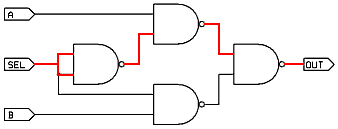The multiplexor is a nice efficient circuit, consisting of only 4 Nand gates. The worst case delay is through the select input and is 3 gate delays:
 x
x ~
zx implemented in Nands is also 3 gate delays.
Adding an inverter to the B input to handle
nx does not change the Mux's worst case delay since this inverter is in parallel, timing wise, with the inverter on SEL.
Xor also takes 3 Nand gate delays, so the circuit speed is also the same for both solutions to handle
nx.
--Mark